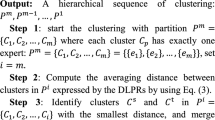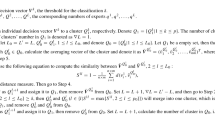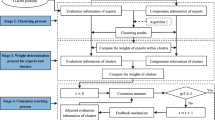Abstract
Large-scale group decision making (LSGDM), which involves a large number of decision makers, has become a hot topic in the field of decision making. To address LSGDM problems with hesitant information, in this paper, a distance-based LSGDM method is proposed by considering group influence. In the method, a generalized distance measure between two pieces of hesitant information is designed to overcome the limitations of existing distance measures. To accelerate the convergence of consensus reaching process with the consideration of the interaction among decision makers, decision makers are divided into several subgroups. The group leader is selected in terms of the contributions of decision makers to group consensus. In order to help generate a satisfactory solution by adequately considering the decision makers’ diverse opinions, the group discussion is introduced to clarify their opinions and minimize bias under the organization of the selected group leader. Based on the changes in the preference information before and after group discussion, the influence of each subgroup is generated and further applied to determine the weights of subgroups. Simulation and comparison experiments are conducted to demonstrate the applicability and effectiveness of the proposed method.










Similar content being viewed by others
References
Chu, J.F., Wang, Y.M., Liu, X.W., Liu, Y.C.: Social network community analysis based large-scale group decision making approach with incomplete fuzzy preference relations. Inform. Fusion 60, 98–120 (2020)
Dong, Y.C., Zhang, H.J., Herrera-Viedma, E.: Integrating experts’ weights generated dynamically into the consensus reaching process and its application in managing non-cooperative behaviors. Decis. Support Syst. 84, 1–15 (2016)
Dong, Y.C., Zhao, S.H., Zhang, H.J., Francisco, C., Herrera-Viedma, E.: A self-management mechanism for noncooperative behaviors in large-scale group consensus reaching processes. IEEE Trans. Fuzzy Syst. 26(6), 3276–3288 (2018)
Ding, R.X., Palomares, I., Wang, X.Q., Yang, G.R., Liu, B.S., Dong, Y.C., Herrera-Viedma, E., Herrera, F.: Large-Scale decision-making: characterization, taxonomy, challenges and future directions from an Artificial Intelligence and applications perspective. Inform. Fusion 59, 84–102 (2020)
Frey, B.J., Dueck, D.: Clustering by passing messages between data points. Science 315(5814), 972–976 (2007)
Fu, C., Yang, S.L.: An evidential reasoning based consensus model for multiple attribute group decision analysis problems with interval-valued group consensus requirements. Eur. J. Oper. Res. 223, 167–176 (2012)
Gou, X.J., Xu, Z.S., Herrera, F.: Consensus reaching process for large-scale group decision making with double hierarchy hesitant fuzzy linguistic preference relations. Knowl.-Based Syst. 157, 20–33 (2018)
Geng, Z.Q., Zeng, R.F., Han, Y.M., Zhong, Y.H., Fu, H.: Energy efficiency evaluation and energy saving based on DEA integrated affinity propagation clustering: case study of complex petrochemical industries. Energy 179, 863–875 (2019)
He, Y., Xu, Z.S.: Error analysis methods for group decision making based on hesitant fuzzy preference relation. Int. J. Intell. Syst. 31(11), 1104–1128 (2016)
Kamis, N.H., Chiclana, F., Levesley, J.: Preference similarity network structural equivalence clustering based consensus group decision making model. Appl. Soft Comput. 67, 706–720 (2018)
Li, C.C., Dong, Y.C., Herrera, F.: A consensus model for large-scale linguistic group decision making with a feedback recommendation based on clustered personalized individual semantics and opposing consensus groups. IEEE Trans. Fuzzy Syst. 27(2), 221–233 (2019)
Li, S.L., Wei, C.P.: A two-stage dynamic influence model-achieving decision-making consensus within large scale groups operating with incomplete information. Knowl.-Based Syst. 189, 9 (2020)
Li, D.Q., Zeng, W.Y., Zhao, Y.B.: Note on distance measure of hesitant fuzzy sets. Inform. Sci. 321, 103–115 (2015)
Liao, H.C., Wu, X.L., Keikha, A., Hafezalkotob, A.: Power average-based score function and extension rule of hesitant fuzzy set and the hesitant power average operators. J. Intell. Fuzzy Syst. 35(3), 3873–3882 (2018)
Liu, X., Xu, Y.J., Herrera, F.: Consensus model for large-scale group decision making based on fuzzy preference relation with self-confidence: detecting and managing overconfidence behaviors. Inform. Fusion 52, 245–256 (2019)
Liu, X., Xu, Y.J., Montes, R., Ding, R.X., Herrera, F.: Alternative ranking-based clustering and reliability index-based consensus reaching process for hesitant fuzzy large scale group decision making. IEEE Trans. Fuzzy Syst. 27(1), 59–171 (2019)
Ma, Z.Z., Zhu, J.J., Ponnambalam, K., Zhang, S.T.: A clustering method for large-scale group decision-making with multi-stage hesitant fuzzy linguistic terms. Inform. Fusion 50, 231–250 (2019)
Palomares, I., Martinez, L., Herrera, F.: A consensus model to detect and manage noncooperative behaviors in large-scale group decision making. IEEE Trans. Fuzzy Syst. 22(3), 516–530 (2014)
Quesada, F.J., Palomares, I., Martínez, L.: Managing experts behavior in large-scale consensus reaching processes with uninorm aggregation operators. Appl. Soft Comput. 35, 873–887 (2015)
Rodríguez, R.M., Labella, A., Tré, G.D., Martínez, L.: A large scale consensus reaching process managing group hesitation. Knowl.-Based Syst. 159, 86–97 (2018)
Song, Y.M., Hu, J.: Large-scale group decision making with multiple stakeholders based on probabilistic linguistic preference relation. Appl. Soft Comput. 80, 712–722 (2019)
Tang, M., Liao, H.C., Xu, J.P., Dalia, S., Zheng, X.S.: Adaptive consensus reaching process with hybrid strategies for large-scale group decision making. Eur. J. Oper. Res. 282, 957–971 (2020)
Tang, M., Zhou, X.Y., Liao, H.C., Xu, J.P., Fujita, H., Herrera, F.: Ordinal consensus measure with objective threshold for heterogeneous large-scale group decision making. Knowl.-Based Syst. 180, 62–74 (2019)
Wang, Z.J., Zhan, Z.H., Lin, Y., Yu, W.J., Yuan, H.Q., Gu, T.L., Kwong, S., Zhang, J.: Dual-strategy differential evolution with affinity propagation clustering for multimodal optimization problems. IEEE Trans. Evol. Comput. 22(6), 894–908 (2018)
Wang, L., Cheng, S.H.: Data-driven resource management for ultra-dense small cells: an affinity propagation clustering approach. IEEE Trans. Net Sci. Eng. 6(3), 267–279 (2019)
Wu, Z.B., Xu, J.P.: A consensus model for large-scale group decision making with hesitant fuzzy information and changeable clusters. Inform. Fusion 41, 217–231 (2018)
Wu, T., Liu, X.W., Liu, F.: An interval type-2 fuzzy TOPSIS model for large scale group decision making problems with social network information. Inform. Sci. 432, 392–410 (2018)
Xu, X.H., Du, Z.J., Chen, X.H.: Consensus model for multi-criteria large-group emergency decision making considering non-cooperative behaviors and minority opinions. Decis. Support Syst. 79, 150–160 (2015)
Xia, M.M., Xu, Z.S.: Hesitant fuzzy information aggregation in decision making. Int. J. Approx Reason 52, 395–407 (2011)
Xiao, J., Wang, X.L., Zhang, H.J.: Managing personalized individual semantics and consensus in linguistic distribution large-scale group decision making. Inform Fusion 53, 20–34 (2020)
Xu, Z.S., Xia, M.M.: Distance and similarity measures for hesitant fuzzy sets. Inform. Sci. 181(11), 2128–2138 (2011)
Yeh, C.T.: Existence of interval, triangular, and trapezoidal approximations of fuzzy numbers under a general condition. Fuzzy Sets Syst. 310, 1–13 (2017)
Zhang, Z.M., Wang, C., Tian, X.D.: A decision support model for group decision making with hesitant fuzzy preference relations. Knowl.-Based Syst. 86, 77–101 (2015)
Zhu, B., Xu, Z.S., Xu, J.P.: Deriving a ranking from hesitant fuzzy preference relations under group decision making. IEEE Trans. Cybernetics 44(8), 1328–1337 (2014)
Zha, Q.B., Liang, H.M., Kou, G., Dong, Y.C., Yu, S.: A feedback mechanism with bounded confidence- based optimization approach for consensus reaching in multiple attribute large-scale group decision-making. IEEE Trans. Fuzzy Syst. 6(5), 994–1006 (2019)
Zhang, H.J., Dong, Y.C., Herrera-Viedma, E.: Consensus Building for the Heterogeneous Large-Scale GDM with the Individual Concerns and Satisfactions. IEEE Trans. Fuzzy Syst. 26(2), 884–898 (2018)
Zhang, X.L., Xu, Z.S.: Novel distance and similarity measures on hesitant fuzzy sets with applications to clustering analysis. J Intell Fuzzy Syst 28(5), 2279–2296 (2015)
Acknowledgements
This research is supported by the Key Technologies Research and Development Program of China (Grant No. 2018AAA0101705), the National Natural Science Foundation of China (Grant Nos. 71622003, 72001063, 71571060, 71690235, 71690230, and 71521001), and the Fundamental Research Funds for the Central Universities of China (Grant Nos. JZ2020HGTA0082).
Author information
Authors and Affiliations
Corresponding author
Appendix: Proof of Theorem 1
Appendix: Proof of Theorem 1
Theorem 1
Suppose that \(h_{ 1} = \{ \gamma_{ 1 1} , \ldots ,\gamma_{{1l(h_{1} )}} \}\) and \(h_{2} = \{ \gamma_{ 2 1} , \ldots ,\gamma_{{ 2l(h_{2} )}} \}\) are two HFEs. The proposed distance measure between h1 and h2 in Eq. (11), i.e., dg(h1, h2), satisfies the following properties:
-
(1)
Boundedness: 0 ≤ dg(h1, h2) ≤ 1.
-
(2)
Commutativity: dg(h1, h2) = dg(h2, h1).
-
(3)
Reflexivity: dg(h1, h2) = 0 iff h1 = h2.
Proof
(1) It can be deduced from Definition 8 that
From \(0 \le \gamma_{1\sigma (j)} ,\gamma_{2\sigma (k)} ,\gamma_{ \cap \sigma (j)} ,\gamma_{ \cap \sigma (k)} \le 1\) and \(1\le \lambda \le + \infty\), it can be known that
Meanwhile, h∩ = h1∩h2 indicates that
In particular, when h1 = h2, i.e., h∩ = h1 = h2, we have \(\sum\nolimits_{j = 1}^{{l(h_{1} )}} {\sum\nolimits_{k = 1}^{{l(h_{2} )}} {\left( {\gamma_{1\sigma (j)} - \gamma_{2\sigma (k)} } \right)^{\lambda } } } = \sum\nolimits_{j = 1}^{{l(h_{ \cap } )}} {\sum\nolimits_{k = 1}^{{l(h_{ \cap } )}} {\left( {\gamma_{ \cap \sigma (j)} - \gamma_{ \cap \sigma (k)} } \right)^{\lambda } } }\) and further dg(h1, h2) = 0. When (h1, h2) = ({0}, {1}) or (h1, h2) = ({1}, {0}), we have dg(h1, h2) = 1.
Therefore, it can be further deduced that 0 ≤ dg(h1, h2) ≤ 1, which indicates that Boundedness is verified.
(2) According to Eq. (11), we have
and \(d_{g} (h_{2} ,h_{1} ) = \left[ {\frac{1}{{l(h_{2} )l(h_{1} )}}\left( {\sum\limits_{j = 1}^{{l(h_{2} )}} {\sum\limits_{k = 1}^{{l(h_{1} )}} {\left( {\gamma_{2\sigma (j)} - \gamma_{1\sigma (k)} } \right)^{\lambda } } } - \sum\limits_{j = 1}^{{l(h_{ \cap } )}} {\sum\limits_{k = 1}^{{l(h_{ \cap } )}} {\left( {\gamma_{ \cap \sigma (j)} - \gamma_{ \cap \sigma (k)} } \right)^{\lambda } } } } \right)} \right]^{1/\lambda } .\)
Because h1 ∩ h2 = h2 ∩ h1, dg(h1, h2) = dg(h2, h1) clearly holds.
As a whole, Commutativity is verified.
(3) First, suppose that h1 = h2. Under the conditions, we have h∩ = h1 = h2. According to Eq. (11), it can be obtained that dg(h1, h2) = 0.
Second, suppose that dg(h1, h2) = 0. Under the conditions, it can be deducted from Eq. (11) that \(\sum\nolimits_{j = 1}^{{l(h_{1} )}} {\sum\nolimits_{k = 1}^{{l(h_{2} )}} {\left( {\gamma_{1\sigma (j)} - \gamma_{2\sigma (k)} } \right)^{\lambda } } } = \sum\nolimits_{j = 1}^{{l(h_{ \cap } )}} {\sum\nolimits_{k = 1}^{{l(h_{ \cap } )}} {\left( {\gamma_{ \cap \sigma (j)} - \gamma_{ \cap \sigma (k)} } \right)^{\lambda } } }\). Through synthetically considering this equation and h∩= h1∩h2, it can be concluded that h∩ = h1 = h2, i.e., h1 = h2.
As a whole, Reflexivity is verified.
The above analyses validate Theorem 1. □
Rights and permissions
About this article
Cite this article
Zhan, Q., Fu, C. & Xue, M. Distance-Based Large-Scale Group Decision-Making Method with Group Influence. Int. J. Fuzzy Syst. 23, 535–554 (2021). https://doi.org/10.1007/s40815-020-00993-9
Received:
Revised:
Accepted:
Published:
Issue Date:
DOI: https://doi.org/10.1007/s40815-020-00993-9




